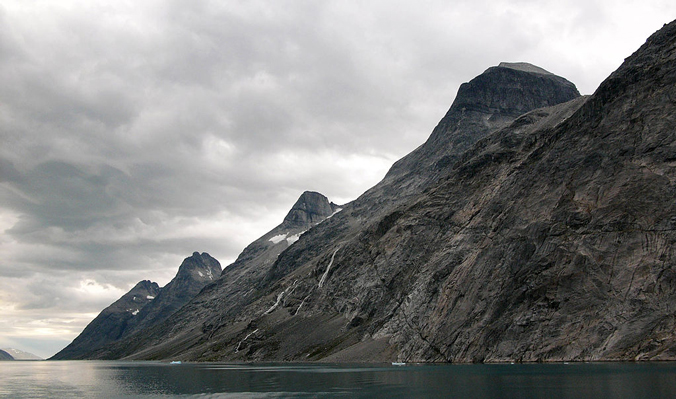About a year ago, one not-your-everyday mother-daughter conversation took place when Pip Hunt called up her mother, Martha. Pip, a former freeskiing competitor and ski coach, had something else up her sleeve for the woman who helped shape her athleticism and sense of adventure. According to Pip, the call went something like this:
“Hey, Mama! Want to sail from Iceland to Greenland?”
“Um, what?”
“I just got off the phone with three other girls and we are going to apply for this grant to sail from Iceland to Greenland and then ski in Greenland. You always want to come on my trips and this would be perfect for you!”
“I’m not sure I’m qualified to sail that far north with all the ice. Can I look into it?”
“Well, we need to submit the grant in about two days, so I kind of need to know if you are interested in being a teammate.”
“Ugh, sure? I mean, we probably won’t get the grant anyway, right?”
Three weeks later, Polartec awarded the Hunts’ Greenland trip, titled Shifting Ice and Changing Tides, with a $5,000 grant to get it off the ground (ultimately fully-funded with the help of sponsors and a crowd-funding campaign). Pip, fellow freeskiers Nat Segal, McKenna Peterson, and Meghan Kelly, and Pip’s mother, Martha, a Royal Yachting Association Master Yachtsman and ski guide at Montana’s Great Northern Powdercats, were left to look into all the unanswered questions and details it would take to plan an open-water crossing between the two remote northern islands—and then go skiing in uncharted territory.
Pip and the team, however wanted more than just another exotic ski trip, a slot that even an intergenerational, female-led and executed adventure expedition didn’t quite fill. “While we were in the planning stages, we really wanted to give back to the skiing community while bringing awareness to different ecological issues we are facing,” Pip says. She turned to Bozeman, Montana-based Adventurers and Scientists for Conservation to see if there was any possibly of her team contributing to their research.
It so happened that one of the main (and currently ongoing) projects at ASC involves working with marine research scientist Abigail Barrows on a global analysis of microplastics (small bits of plastic pollution) in oceans and waterways. ASC put Pip and Barrows in contact, and Barrows explained what types of water samples she wanted, and from what locations and depths. The trip had its higher purpose.
The final step was to bring photographer and skier Kt Miller on board, and head to Iceland. From there, the itinerary was set: cross the Strait of Denmark between Iceland and Greenland, round the southern tip of Greenland, and sail up the west coast exploring fjords and searching for spectacular lines to climb and ski while collecting water and sea-ice samples.
The boat had a long way to go before skis hit the snow with plenty that could happen en route. The open-water crossing to Greenland went smoothly, but the crew of ladies were not about to get off quite so easily. After some ski touring in pleasant weather in a Greenlandic fjord, they headed out for the next destination up the coast, hoping to outrun a storm seen in the weather forecast. They didn’t.
“Sailing during a storm is an entirely different form of fear,” Pip says. “Between the Tassermuit Fjord and Paaimut, the seas swelled to 30 feet, and the winds gusted at over 80k. We left the fjord in daylight under a gray sky and full sail. As the storm picked up, the waves crashed over the deck and we traded positions between the helm and the deck, pulling in sails. Trying to pull the main sail down as the sea surged around us, we narrowly avoided two icebergs and a fishing boat, we lost the bow sprite and the jib to a massive wave. We would be on deck, wrestling heavy, sodden sails as the waves knocked us off our feet and the snow pelted down on us.”
According to Kt Miller, who hadn’t spent time on the open water, and ended up so seasick she couldn’t perform watch duties, the terrifying storm made things very real: “That was when the remoteness of our position hit me. We were really on our own.” It was rough even for those with more experienced in sailing. “We didn’t really eat or sleep for 17 hours, and just about kissed the ground when we finally made it to Paaimut,” Pip says.
After the storm, however, things got back to normal—for a sailing-skiing expedition—and the team concentrated on the fun, the skiing, and their scientific goals.
“Seeing the lack of ice in South Greenland really struck an intimate chord with me. It’s hard living in such a manufactured world [like ours],” Miller says. “But when you’re out on an expedition like that, stripped of modern comforts and conveniences, the frame with which we usually see the world dissolves. I think it isexperiences like this, really getting out there, unplugging and immersing yourself in nature that create environmental stewards, and I hope our story brings some of that back to life.”
Nearly year later, the work from the trip is paying off. Recently, Barrows had the Greenland water samples analyzed and confirmed an average of 10 pieces of microplastic (small bits of plastic or threads under 5mm) per liter. According to Barrows, the team collected some interesting specimens from Greenland’s waters, such as plastic threads and some blue plastic specks that, she theorizes, may be microbeads from
cosmetic products.
For the Shifting Ice crew, the added scientific element became the most important part of the overall adventure. “Absolutely, the most lasting impression our expedition made on me is the microplastic levels in our oceans and the amount of trash we produced on this trip,” Pip says. Kt agrees: “The trip could not have been more of a success. We skied every day we could; we overcame many challenges mentally and physically; we bonded as a team, and we learned a ton about the climate, culture and landscape of that region of the world.”
For more on the expedition, visit shiftingice.org and for more on the research, visit meriresearch.org.












Related posts: